-
LMV11x Low-Voltage, 45-MHz, Rail-To-Rail Output Operational Amplifiers With Shutdown Option
- 1 Features
- 2 Applications
- 3 Description
- 4 Revision History
- 5 Pin Configuration and Functions
- 6 Specifications
- 7 Detailed Description
- 8 Application and Implementation
- 9 Power Supply Recommendations
- 10Layout
- 11Device and Documentation Support
- 12Mechanical, Packaging, and Orderable Information
- IMPORTANT NOTICE
Package Options
Mechanical Data (Package|Pins)
- DBV|5
Thermal pad, mechanical data (Package|Pins)
Orderable Information
LMV11x Low-Voltage, 45-MHz, Rail-To-Rail Output Operational Amplifiers With Shutdown Option
1 Features
- −3-dB BW 45 MHz
- Supply Voltage Range 2.7 V to 12 V
- Slew Rate 40 V/μs
- Supply Current 600 μA
- Power Down Supply Current 15 μA
- Output Short Circuit Current 32 mA
- Linear Output Current ±20 mA
- Input Common Mode Voltage −0.3 V to 1.7 V
- Output Voltage Swing 20 mV from Rails
- Input Voltage Noise 40 nV/√Hz
- Input Current Noise 0.75 pA/√Hz
2 Applications
- High-Speed Clock Buffer/Driver
- Active Filters
- High-Speed Portable Devices
- Multiplexing Applications (LMV118)
- Current Sense Amplifier
- High-Speed Transducer Amplifier
3 Description
The LMV116 (single) rail-to-rail output voltage feedback amplifiers offer high-speed (45 MHz), and low-voltage operation (2.7 V) in addition to micro-power shutdown capability (LMV118).
Output voltage range extends to within 20 mV of either supply rail, allowing wide dynamic range especially in low voltage applications. Even with low supply current of 600 μA, output current capability is kept at a respectable ±20 mA for driving heavier loads. Important device parameters such as BW, slew rate, and output current are kept relatively independent of the operating supply voltage by a combination of process enhancements and design architecture.
For portable applications, the LMV118 provides shutdown capability while keeping the turnoff current to 15 μA. Both turnon and turnoff characteristics are well behaved with minimal output fluctuations during transitions, thus the device can be used in power-saving mode, as well as multiplexing applications. Miniature packages (5-pin and 6-pin SOT-23) are further means to ease the adoption of these low-power, high-speed devices in applications where board area is at a premium.
Device Information(1)
| PART NUMBER | PACKAGE | BODY SIZE (NOM) |
|---|---|---|
| LMV116 | SOT-23 (5) | 2.90 mm × 1.60 mm |
| SOT-23 (6) | 2.90 mm × 1.60 mm | |
| LMV118 | SOT-23 (5) | 2.90 mm × 1.60 mm |
| SOT-23 (6) | 2.90 mm × 1.60 mm |
- For all available packages, see the orderable addendum at the end of the data sheet.
Typical Application
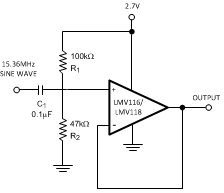
4 Revision History
Changes from B Revision (May 2013) to C Revision
- Added Device Information and Pin Configuration and Functions sections, ESD Ratings and Thermal Information tables, Functional Block Diagram, Feature Description, Device Functional Modes, Application and Implementation, Power Supply Recommendations, Layout, Device and Documentation Support, and Mechanical, Packaging, and Orderable Information sectionsGo
- Changed RθJA from 265°C/W to 182.7°C/WGo
Changes from A Revision (May 2013) to B Revision
- Changed layout of National Semiconductor data sheet to TI formatGo
5 Pin Configuration and Functions


Pin Functions
| PIN | I/O | DESCRIPTION | ||
|---|---|---|---|---|
| NAME | LMV116 | LMV118 | ||
| +IN | 3 | 3 | Input | Non-inverting input |
| –IN | 4 | 4 | Input | Inverting input |
| OUTPUT | 1 | 1 | Output | Output |
| SD | — | 5 | Input | Shutdown input. Active high, must be tied to V– with resistor for normal operation. |
| V+ | 5 | 6 | Power | Positive (highest) power supply |
| V– | 2 | 2 | Power | Negative (lowest) power supply |
6 Specifications
6.1 Absolute Maximum Ratings
over operating free-air temperature range (unless otherwise noted)(1)(2)| MIN | MAX | UNIT | ||
|---|---|---|---|---|
| Supply voltage (V+ - V−) | 12.6 | V | ||
| Voltage at INPUT and OUTPUT pins | V− −0.8 | V+ + 0.8 | V | |
| Output short-circuit duration | See(3), (4) | |||
| Junction temperature(5) | 150 | °C | ||
| Soldering information | Infrared or convection (20 seconds) | 235 | °C | |
| Wave soldering lead temperature (10 seconds) | 260 | °C | ||
| Storage temperature, Tstg | –65 | 150 | °C | |
6.2 ESD Ratings
| VALUE | UNIT | |||
|---|---|---|---|---|
| V(ESD) | Electrostatic discharge | Human-body model (HBM), per ANSI/ESDA/JEDEC JS-001(1) | ±2000 | V |
| Machine model | ±200 | |||
6.3 Recommended Operating Conditions
over operating free-air temperature range (unless otherwise noted)| MIN | NOM | MAX | UNIT | ||
|---|---|---|---|---|---|
| Supply voltage (V+ – V−) | 2.5 | 12 | V | ||
| Temperature(1) | −40 | 85 | °C | ||
6.4 Thermal Information
| THERMAL METRIC(1) | LMV116 | LMV118 | UNIT | |
|---|---|---|---|---|
| DBV (SOT-23) | DBV (SOT-23) | |||
| 5 PINS | 6 PINS | |||
| RθJA | Junction-to-ambient thermal resistance | 182.7 | 182.7 | °C/W |
| RθJC(top) | Junction-to-case (top) thermal resistance | 139.9 | 139.9 | °C/W |
| RθJB | Junction-to-board thermal resistance | 41.4 | 41.4 | °C/W |
| ψJT | Junction-to-top characterization parameter | 28.5 | 28.5 | °C/W |
| ψJB | Junction-to-board characterization parameter | 40.9 | 40.9 | °C/W |
6.5 Electrical Characteristics: 2.7 V
Unless otherwise specified, all limits apply for TJ = 25°C, V+ = 2.7 V, V− = 0 V, VCM = VO = V+ / 2, and RF = 2 kΩ, andRL = 1 kΩ to V+ / 2.
| PARAMETER | TEST CONDITIONS | MIN(1) | TYP(2) | MAX(1) | UNIT | |
|---|---|---|---|---|---|---|
| VOS | Input offset voltage | 0 V ≤ VCM ≤ 1.7 V | ±1 | ±5 | mV | |
| 0 V ≤ VCM ≤ 1.7 V –40°C to 85°C |
±6 | |||||
| TC VOS | Input offset average drift | See(3) | ±5 | μV/C | ||
| IB | Input bias current | See(4) | −2 | −0.4 | μA | |
| See(4), –40°C to 85°C | –2.2 | |||||
| IOS | Input offset current | 1 | 500 | nA | ||
| CMRR | Common mode rejection ratio | VCM stepped from 0 V to 1.55 V | 73 | 88 | dB | |
| PSRR | Power supply rejection ratio | V+ = 2.7 V to 3.7 V or V− = 0 V to −1 V | 72 | 85 | dB | |
| RIN | Common mode input resistance | 3 | MΩ | |||
| CIN | Common mode input capacitance | 2 | pF | |||
| CMVR | Input common-mode voltage range | CMRR ≥ 50 dB | −0.3 | 1.7 | V | |
| CMRR ≥ 50 dB, –40°C to 85°C | –0.1 | |||||
| AVOL | Large signal voltage gain | VO = 0.35 V to 2.35 V | 73 | 87 | dB | |
| VO = 0.35 V to 2.35 V, –40°C to 85°C | 70 | |||||
| VO | Output swing high | RL = 1 kΩ to V+/2 | 2.55 | 2.66 | V | |
| RL = 10 kΩ to V+/2 | 2.68 | |||||
| Output swing low | RL = 1 kΩ to V+/2 | 150 | 40 | mV | ||
| RL = 10 kΩ to V+/2 | 20 | |||||
| ISC | Output short-circuit current | Sourcing to V−
VID = 200 mV(5) |
25 | 35 | mA | |
| Sinking to V+
VID = −200 mV(5) |
25 | 32 | ||||
| IOUT | Output current | VOUT = 0.5 V from rails | ±20 | mA | ||
| IS | Supply current | Normal operation | 600 | 900 | μA | |
| Shutdown mode (LMV118) | 15 | 50 | ||||
| SR | Slew rate (6) | AV = +1, VO = 1 VPP | 40 | V/μs | ||
| BW | −3 dB BW | AV = +1, VOUT = 200 mVPP | 45 | MHz | ||
| en | Input-referred voltage noise | f = 100 kHz | 40 | nV/√Hz | ||
| f = 1 kHz | 60 | |||||
| in | Input-referred current noise | f = 100 kHz | 0.75 | pA/√Hz | ||
| f = 1 kHz | 1.2 | |||||
| ton | Turnon time (LMV118) | 250 | ns | |||
| toff | Turnoff time (LMV118) | 560 | ns | |||
| THSD | Shutdown threshold (LMV118) | IS ≤ 50 μA | 1.95 | 2.3 | V | |
| ISD | SHUTDOWN pin input current (LMV118) | See(4) | −20 | μA | ||
6.6 Electrical Characteristics: 5 V
Unless otherwise specified, all limits apply for TJ = 25°C, V+ = 5 V, V− = 0 V, VCM = VO = V+/2, and RF = 2 kΩ, and RL = 1 kΩ to V+/2.| PARAMETER | TEST CONDITIONS | MIN(1) | TYP(2) | MAX(1) | UNIT | |
|---|---|---|---|---|---|---|
| VOS | Input offset voltage | 0 V ≤ VCM ≤ 1.7 V | ±1 | ±5 | mV | |
| 0 V ≤ VCM ≤ 1.7 V –40°C to 85°C |
±6 | |||||
| TC VOS | Input offset average drift | See(3) | ±5 | μV/C | ||
| IB | Input bias current | See(4) | −2 | −0.4 | μA | |
| See(4), –40°C to 85°C | –2.2 | |||||
| IOS | Input offset current | 1 | 500 | nA | ||
| CMRR | Common mode rejection ratio | VCM stepped from 0 V to 3.8 V | 77 | 85 | dB | |
| PSRR | Power supply rejection ratio | V+ = 5 V to 6 V or V− = 0 V to −1 V | 72 | 95 | dB | |
| RIN | Common mode input resistance | 3 | MΩ | |||
| CIN | Common mode input capacitance | 2 | pF | |||
| CMVR | Input common-mode voltage range | CMRR ≥ 50 dB | −0.3 | 4 | V | |
| CMRR ≥ 50 dB, –40°C to 85°C | –0.1 | |||||
| AVOL | Large signal voltage gain | VO = 1.5 V to 3.5 V | 73 | 87 | dB | |
| VO = 1.5 V to 3.5 V, –40°C to 85°C | 70 | |||||
| VO | Output swing high | RL = 1 kΩ to V+/2 | 4.8 | 4.95 | V | |
| RL = 10 kΩ to V+/2 | 4.98 | |||||
| Output swing low | RL = 1 kΩ to V+/2 | 200 | 50 | mV | ||
| RL = 10 kΩ to V+/2 | 20 | |||||
| ISC | Output short-circuit current | Sourcing to V−
VID = 200 mV(5) |
35 | 45 | mA | |
| Sinking to V+
VID = –200 mV(5) |
35 | 43 | ||||
| IOUT | Output current | VOUT = 0.5 V from rails | ±20 | mA | ||
| IS | Supply current | Normal operation | 600 | 900 | μA | |
| Shutdown mode (LMV118) | 10 | 50 | ||||
| SR | Slew rate (6) | AV = +1, VO = 1 VPP | 40 | V/μs | ||
| BW | −3 dB BW | AV = +1, VOUT = 200 mVPP | 45 | MHz | ||
| en | Input-referred voltage noise | f = 100 kHz | 40 | nV/√Hz | ||
| f = 1 kHz | 60 | |||||
| in | Input-referred current noise | f = 100 kHz | 0.75 | pA/√Hz | ||
| f = 1 kHz | 1.2 | |||||
| ton | Turnon time (LMV118) | 210 | ns | |||
| toff | Turnoff time (LMV118) | 500 | ns | |||
| THSD | Shutdown threshold (LMV118) | IS ≤ 50 μA | 4.25 | 4.6 | V | |
| ISD | SHUTDOWN pin input current (LMV118) | See(4) | −20 | μA | ||
6.7 Electrical Characteristics: ±5 V
Unless otherwise specified, all limits apply for TJ = 25°C, V+ = 5 V, V− = –5 V, VCM = VO = 0 V, and RF = 2 kΩ, and RL = 1 kΩ to V+/2.| PARAMETER | TEST CONDITIONS | MIN(1) | TYP(2) | MAX(1) | UNIT | |
|---|---|---|---|---|---|---|
| VOS | Input offset voltage | 0 V ≤ VCM ≤ 1.7 V | ±1 | ±5 | mV | |
| 0 V ≤ VCM ≤ 1.7 V –40°C to 85°C |
±6 | |||||
| TC VOS | Input offset average drift | See(3) | ±5 | μV/C | ||
| IB | Input bias current | See(4) | −2 | −0.4 | μA | |
| See(4), –40°C to 85°C | –2.2 | |||||
| IOS | Input offset current | 3 | 500 | nA | ||
| CMRR | Common mode rejection ratio | VCM stepped from 0 V to 3.8 V | 78 | 104 | dB | |
| PSRR | Power supply rejection ratio | V+ = 5 V to 6 V or V− = 0 V to −1 V | 72 | 95 | dB | |
| RIN | Common mode input resistance | 3 | MΩ | |||
| CIN | Common mode input capacitance | 2 | pF | |||
| CMVR | Input common-mode voltage range | CMRR ≥ 50 dB | −5.3 | 4 | V | |
| CMRR ≥ 50 dB, –40°C to 85°C | –5.1 | |||||
| AVOL | Large signal voltage gain | VO = 1.5 V to 3.5 V | 74 | 85 | dB | |
| VO = 1.5 V to 3.5 V, –40°C to 85°C | 71 | |||||
| VO | Output swing high | RL = 1 kΩ to V+/2 | 4.7 | 4.92 | V | |
| RL = 10 kΩ to V+/2 | 4.97 | |||||
| Output swing low | RL = 1 kΩ to V+/2 | –4.7 | –4.92 | V | ||
| RL = 10 kΩ to V+/2 | –4.98 | |||||
| ISC | Output short-circuit current | Sourcing to V−
VID = 200 mV(5) |
40 | 57 | mA | |
| Sinking to V+
VID = −200 mV(5) |
40 | 54 | ||||
| IOUT | Output current | VOUT = 0.5 V from rails | ±20 | mA | ||
| IS | Supply current | Normal operation | 600 | 900 | μA | |
| Shutdown mode (LMV118) | 15 | 50 | ||||
| SR | Slew rate (6) | AV = 1, VO = 1 VPP | 35 | V/μs | ||
| BW | −3 dB BW | AV = 1, VOUT = 200 mVPP | 45 | MHz | ||
| en | Input-referred voltage noise | f = 100 kHz | 40 | nV/√Hz | ||
| f = 1 kHz | 60 | |||||
| in | Input-referred current noise | f = 100 kHz | 0.75 | pA/√Hz | ||
| f = 1 kHz | 1.2 | |||||
| ton | Turnon time (LMV118) | 200 | ns | |||
| toff | Turnoff time (LMV118) | 700 | ns | |||
| THSD | Shutdown threshold (LMV118) | IS ≤ 50 μA | 4.25 | 4.6 | V | |
| ISD | SHUTDOWN pin input current (LMV118) | See(4) | −20 | μA | ||
6.8 Typical Characteristics
At TJ = 25°C. Unless otherwise specified.





(a Typical Unit)
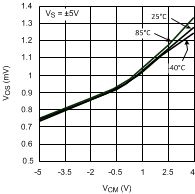
(a Typical Unit)
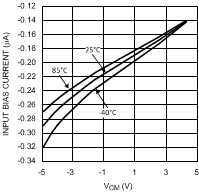
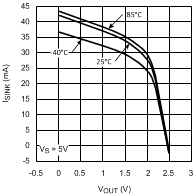



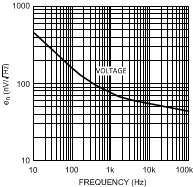

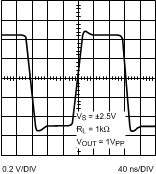
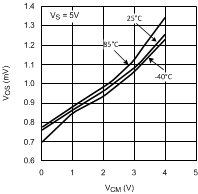



7 Detailed Description
7.1 Overview
The LMV116 and LMV118 are based on TI’s proprietary VIP10 dielectrically isolated bipolar process.
The LMV116 and LMV118 architecture features the following:
- Complementary bipolar devices with exceptionally high ft (approximately 8 GHz) even under low supply voltage (2.7 V) and low collector bias current.
- Common emitter push-pull output stage capable of 20-mA output current (at 0.5 V from the supply rails) while consuming only 600 μA of total supply current. This architecture allows output to reach within milli-volts of either supply rail at light loads.
- Consistent performance from any supply voltage (2.7 V to 10 V) with little variation with supply voltage for the most important specifications (for example, BW, SR, IOUT, etc.)
7.2 Functional Block Diagram

7.3 Feature Description
The amplifier's differential inputs consist of a non-inverting input (+IN) and an inverting input (–IN). The amplifier amplifies only the difference in voltage between the two inputs, which is called the differential input voltage. The output voltage of the op-amp VOUT is given by Equation 1:
where
- AVOL is the open-loop gain of the amplifier, typically around 85 dB.
7.4 Device Functional Modes
7.4.1 Quasi-Saturated State
When the output swing approaches either supply rail, the output transistor enters a quasi-saturated state. A subtle effect of this operational region is that there is an increase in supply current in this state (up to 1 mA). The onset of quasi-saturation region is a function of output loading (current) and varies from 100 mV at no load to about 1 V when output is delivering 20 mA, as measured from supplies. Both input common mode voltage and output voltage level affect the supply current (see Typical Characteristics for plot).
7.4.2 Micro-Power Shutdown
The LMV118 can be shut down to save power and reduce its supply current to less than the 50 μA specified by applying a voltage to the SD pin. The SD pin is active high and needs to be tied to V− for normal operation. This input is low current (< 20-μA, 4-pF equivalent capacitance) and a resistor to V− (≤ 20 kΩ) results in normal operation. Shutdown is specified when SD pin is 0.4 V or less from V+ at any operating supply voltage and temperature.
In the shutdown mode, essentially all internal device biasing is turned off in order to minimize supply current flow, and the output goes into Hi-Z (high impedance) mode. Complete device turnon and turnoff times vary considerably relative to the output loading conditions, output voltage, and input impedance, but is generally limited to less than 1 μs (see Electrical Characteristics: 2.7 V, Electrical Characteristics: 5 V, and Electrical Characteristics: ±5 V)
During shutdown, the input stage has an equivalent circuit as shown in Figure 20.
 Figure 20. Input Stage Shutdown Equivalent Circuit
Figure 20. Input Stage Shutdown Equivalent Circuit
As can be seen from Figure 20, in shutdown there may be current flow through the internal diodes shown, caused by input potential, if present. This current may flow through the external feedback resistor and result in an apparent output signal. In most shutdown applications the presence of this output is inconsequential. However, if the output is forced by another device such as in a multiplexer, the other device must conduct the current described in order to maintain the output potential.
To keep the output at or near ground during shutdown when there is no other device to hold the output low, a switch (transistor) could be used to shunt the output to ground. Figure 21 shows a circuit where a NPN bipolar is used to keep the output near ground (approximately 80 mV):
 Figure 21. Active Pulldown Schematic
Figure 21. Active Pulldown Schematic
Figure 22 shows the output waveform.
 Figure 22. Output Held Low by Active Pulldown Circuit
Figure 22. Output Held Low by Active Pulldown Circuit
If bipolar transistor power dissipation is not tolerable, the switch can be done by an N-channel enhancement-mode MOSFET.